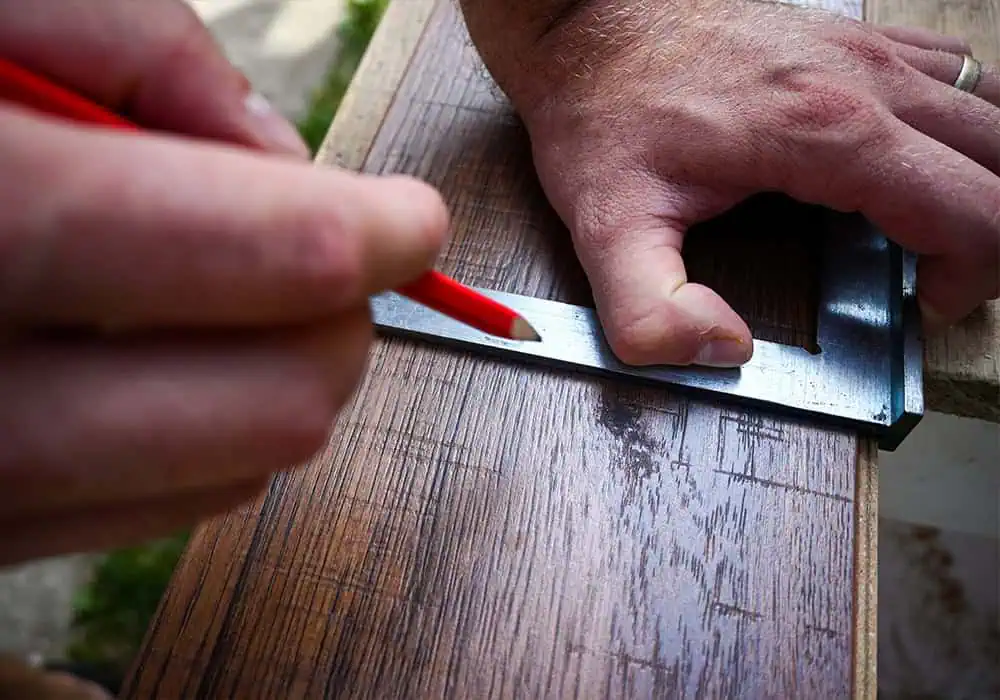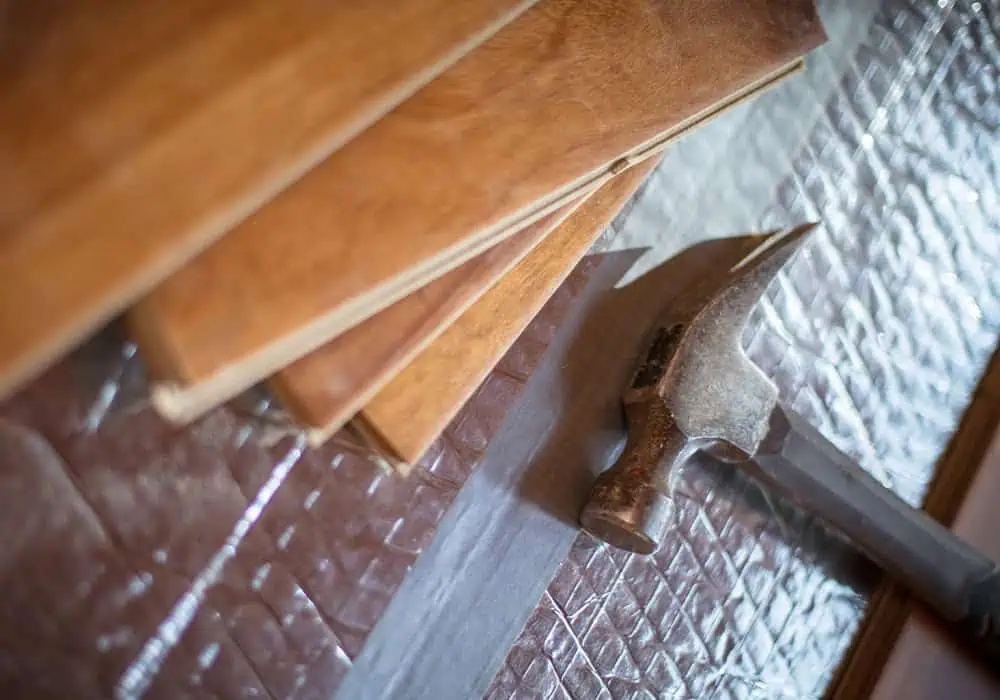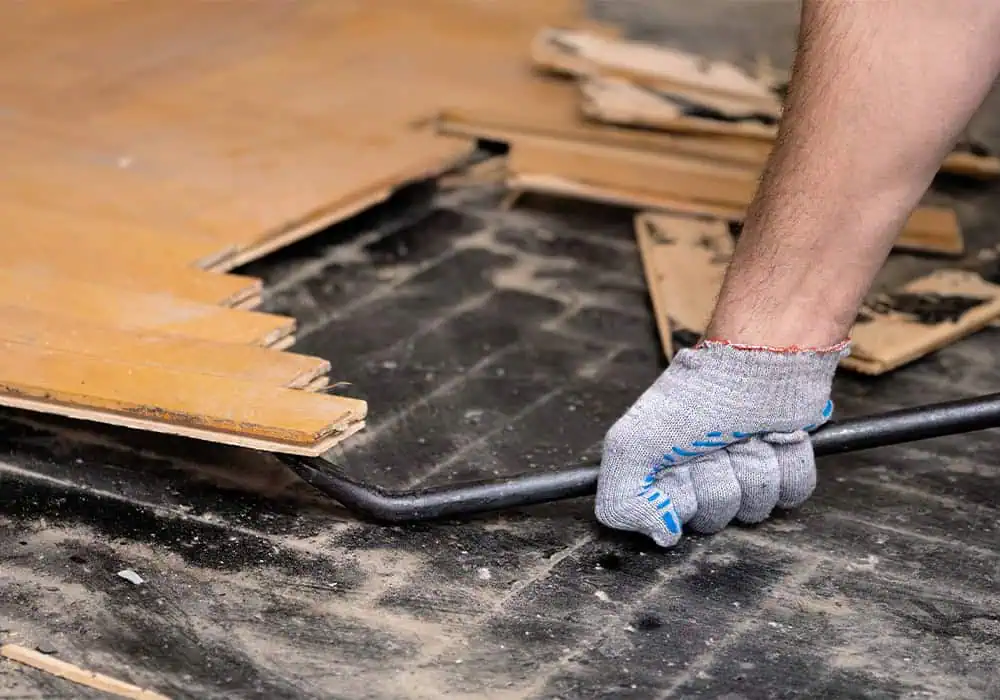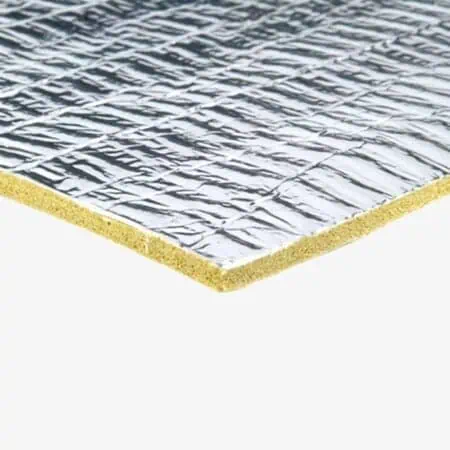Several factors can impact the cost of laying new laminate flooring in your home. This guide will arm you with the latest UK average prices, saving you time and giving you a clear idea of what to expect as you start gathering quotes.
We’ll walk you through the costs of purchasing laminate, adding underlay and the installation process, along with any extra services you might need. You’ll also learn how things like the type of laminate, the shape of the room and the installation method can influence the final price.
Whether you plan to fit laminate in a single room or throughout your home, this guide will help you budget and avoid getting ripped off.
In this guide
Laminate flooring installation at a glance
Average laminate flooring prices: £5 – £30+ per m2
Average underlay cost: £2 – £10 per m2
Average laminate flooring fitter day rate: £150 – £250 per day
What affects the cost of laying laminate flooring?
The type of laminate you choose

Laminate flooring is typically priced per square metre (m²), and the cost can vary significantly depending on these factors:
Material quality: Laminate comes in different grades, with the quality of the material playing a huge role in the price.
Construction: The construction method of laminate flooring also affects the price. Made from multiple layers, premium products often have thicker cores – making them sturdier and more expensive.
Durability: Laminates with extra features—like moisture-resistant options for kitchens and bathrooms or those designed to withstand heavy foot traffic—will always hit a higher price bracket. AC ratings (Abrasion Class) indicate how durable a laminate is, with higher ratings (AC4 or AC5) ideal for busy areas of the home but coming at a premium.
Sustainability: Eco-friendly options are becoming more popular, with some brands now offering laminate made from recycled materials or low VOC (volatile organic compounds) content. As you’d expect, these options tend to cost more due to an environmentally friendly production process.
Style: The look of laminate flooring can impact its price. More intricate designs, like those mimicking wood grains or patterns, are typically more expensive than simpler, plain styles.
Thickness: Thicker laminate (8mm or more) generally costs more than thinner options (6mm) as it offers better soundproofing and durability. You get what you pay for!
Brand: Well-known laminate brands such as Quick-Step or Pergo have higher prices due to their reputation for quality and reliability. Cheaper, unbranded options may help you save money upfront, but they might not offer the same long-term durability.
Average laminate costs per m2

In the UK, laminate flooring prices can range from £5 to £30+ per m², depending on the brand, quality and specific features. Here’s a breakdown of the latest average laminate costs per m² based on quality:
Budget Laminate: £5 – £10 per m²
Value options are typically the most affordable, making them an attractive choice for homeowners looking to save money.
Made from thinner (6-8mm), lower-density materials, they usually have a lower AC rating (AC1 or AC2), making them suitable for rooms with light to moderate foot traffic.
Mid-Range Laminate: £10 – £20 per m²
Mid-range laminates balance quality, durability and price, making them a popular choice for homeowners who want something longer-lasting.
These laminates are made from higher-quality materials, often featuring a thicker core (8-12mm) that adds strength and stability. This makes them perfect for high-traffic areas like living rooms and kitchens. They also come in a wider range of designs, colours and finishes.
High-End Laminate: £20 – £30+ per m²
Premium laminates offer the best quality, style and performance, making them the only choice for discerning homeowners.
Often constructed from thicker (12mm+) high-density fibreboard (HDF), these products are ideal for heavy-footfall areas and are built to last for years.
They also offer the broadest range of designs, patterns and textures.
Laminate flooring fitter costs

Fitting costs for laminate flooring are typically calculated per square metre and vary depending on your location and the complexity of the job. Investing in a skilled installer guarantees a professional finish, but many homeowners successfully lay it themselves.
The average day rate for a laminate installer varies from £150 to £250, depending on your project and location.
TOP TIP: Always get a few quotes to avoid getting ripped off. Make sure the quote details all aspects of the job, including any extras like removing skirting boards or disposing of waste.
Room size and shape
The size and layout of your room will greatly impact your overall expenses. Larger rooms naturally require more materials, driving up the cost of the laminate itself and the installation fees.
The shape of your room also plays a part. If your space is irregular or has many nooks and corners, it can make installation more complicated, leading to higher fitting costs.
PRO TIP: Measure your room carefully and include any alcoves or odd angles to get an accurate estimate of how much flooring you’ll need.
Installation method

When laying laminate flooring, fitting costs will vary depending on the method you choose. Whether you decide to hire a fitter or go it alone – it’s important to use the right installation method for your space.
Here’s a breakdown of the different options to help you decide which one works best for you:
Floating (click-lock method)
The floating method is the most common option. It involves snapping the laminate planks together using a click-lock system. No glue or nails are needed; your laminate simply ‘floats’ above your subfloor.
Ideal for:
- DIY enthusiasts and those who want a quick, easy installation
- Concrete or existing subfloors
- Areas prone to humidity as the laminate has room to expand and contract
- Underfloor heating – make sure you choose a laminate (and underlay) that’s compatible.
Pros:
- The most budget-friendly option as it’s quick and easy to lay (or you could save on fitting fees completely by having a go yourself)
- Less messy than other methods
- Perfect for most areas in the home
- Planks can be moved or replaced easily
- Lifespan can be extended with a quality underlay
Cons:
- Can feel less stable underfoot compared to glue-down or nail-down options
- Not ideal for areas with heavy furniture, as it may shift slightly over time
- If the subfloor is uneven, it can affect the feel and appearance of the laminate
Glue-down
This method involves glueing each plank directly to the subfloor for a more permanent installation.
Ideal for:
- Spaces where stability is a priority, like high-traffic areas
- Rooms with heavy furniture, as it’s less likely to shift over time
- Areas prone to spills or moisture
Pros:
- Provides a strong, solid surface with little movement
- Prevents water from seeping underneath the flooring
- Can be less prone to gaping and separating over time
Cons:
- More time-consuming, which will cost more in fitting fees
- Messy to install due to the adhesive
- Harder to replace individual planks, as they are glued to the subfloor
- Requires a perfectly level subfloor for the best results, so prep work may be needed – bumping up the overall cost
- Can be difficult and costly to remove if you want to change flooring later
Nail-down
This method involves securing the laminate planks by nailing them to a wooden subfloor.
Best for:
- Laminate with a thicker core
- Homes with wood subfloors
- Those looking for a highly durable, traditional installation
Pros:
- A sturdy, reliable installation method
Cons:
- More labour-intensive, which can increase installation time and costs.
- Requires professional tools and skills, making it less DIY-friendly
- Can only be installed over wooden subfloors
- Not a common method for laminate, so it might not be compatible with all laminate products
Laminate underlay
Whether you’re working with a concrete or wood subfloor, we always recommend laying a quality laminate underlay (between 3-5mm thick) beneath your flooring. Not only can it smooth out minor dips (up to 3mm), but it also helps keep the heat in and the noise down and protects your flooring against premature wear—especially in high-traffic areas.
Underlay comes in different materials, thicknesses and densities—varying in quality, features and price points—and it’s important to choose one compatible with your space. For instance, an underlay with a built-in vapour barrier is crucial for moisture-prone areas like concrete subfloors. Though it’s often seen as a luxury option, its special features make it possible to lay laminate flooring in challenging conditions.
The type you go for will influence your overall expenses. For example, some products are easier and quicker to fit, which can help reduce your labour costs.
GOOD TO KNOW: A cheaper underlay might save you money now, but investing in a higher-quality option will improve the lifespan and performance of your laminate – saving you money in the long run.
Average laminate flooring underlay costs per m²
Here are the latest average prices for laminate flooring underlay broken down by quality:
| Laminate Flooring Underlay | Average Cost |
|---|---|
| Budget | £1 to £3 per m² |
| Mid-Range | £4 to £6 per m² |
| Premium | £6 to £8 per m² |
Additional fitting costs to consider

Beyond the cost of the laminate and underlay, there are other services you might need – depending on your situation. These can add to your overall spend:
Room clearance: Some fitters will expect the room to be cleared before they arrive, so if you need help moving furniture, they might charge extra.
Removal and disposal of old flooring and underlay: Pulling up existing carpet or laminate flooring and removing it can add to your bill. It’s worth checking whether this is included in the installation price.
Subfloor repairs: When you remove old flooring, you might find issues like an uneven surface, broken floorboards or moisture – these need to be sorted out before laying the new laminate. Check if your fitter can handle this or if you need to hire another flooring expert, which will add more to your costs.
Door easing: Laying laminate flooring might raise the height of your floor, so bear in mind that your doors might need adjusting to allow them to open and close without catching. Your fitter may offer this service, but it might not be included in the price.
Extra materials: Things like adhesive, door threshold strips and expansion gap spacers can also add to your total costs. It’s a good idea to check in with your fitter about what is and isn’t included in their quote.
The table below includes the latest average costs you can expect to pay for laminate flooring fitting extras:
| Additional Laminate Fitting Services / Products | Average Prices |
|---|---|
| Room clearance | £10 to £15 per room |
| Old flooring removal / disposal | £5 to £5 per m² |
| Subfloor repairs | £10 to £30 per m² |
| Door easing | £20 to £50 per door |
| Adhesive | £10 to £30 per 1 litre bottle |
| Door thresholds | £5 to £30 each |
| Expansion gap spacers | £5 to £10 per pack |
Average UK cost for laminate flooring installation
Standard 3m x 4m room
The total cost will vary based on several factors, but to give you a better idea to help you budget, the table below shows average costs for budget, mid-range and high-end options for installing laminate flooring in a 3m x 4m room.
| Costs | Budget | Mid-Range | Premium |
|---|---|---|---|
| Laminate flooring | £60 to £120 | £120 to £240 | £240 to £360 |
| Underlay | £12 to £36 | £36 to £72 | £72 to £96 |
| Adhesives | £10 to £30 | £10 to £30 | £10 to £30 |
| Labour | £120 to £240 | £120 to £240 | £120 to £240 |
| Total cost | £202 to £426 | £286 to £582 | £442 to £726 |
Regular 12-step flight of stairs
Using the same examples, the average price of laying a standard 12-step straight staircase with laminate flooring could be:
| Costs | Budget | Mid-Range | High-End |
|---|---|---|---|
| Laminate flooring | £7.50 to £15 | £15 to £30 | £30 to £45 |
| Underlay | £1.50 to £4.50 | £4.50 to £9 | £9 to £12 |
| Adhesives * | £10 to £30 | £10 to £30 | £10 to £30 |
| Labour | £60 to £120 | £60 to £120 | £60 to £120 |
| Total cost | £79 to £169.50 | £89.5 to £189 | £109 to £207 |
* Note: When fitting laminate flooring on stairs, you won’t need a full tub of adhesive. If you’re also laminating other areas in your home, the cost of adhesive will be lower since you can share it across different spaces.
GOOD TO KNOW: Curved or winding staircases need more laminate flooring, additional cutting, and specialised skills, increasing the overall cost.
10 tips for saving on laminate flooring costs

If you’re on a budget, there are ways to reduce the overall cost of laying new laminate flooring:
- Measure your space correctly to minimise waste
- Shop around for suppliers and fitters for the best prices
- Take advantage of seasonal sales, promotions and clearance items
- If you’ve got spare time, consider tackling the laminate or underlay installation yourself
- Check that quotes include extras like the removal of old flooring and threshold strips
- Choose click-lock installation for the most cost-effective solution
- Use offcuts from larger spaces for smaller areas to avoid waste
- Online retailers often have lower overheads, so buy online for better deals
- Clear the space of furniture and old flooring yourself to save on fitter costs
- Don’t scrimp on underlay – this will stop you replacing your laminate prematurely
Now you’re prepared
Now that you’re aware of everything that can influence the overall cost of laying laminate—especially those hidden expenses—you’ll be able to budget confidently, avoid any surprises and ensure you’re getting the best quality and value.
Enjoy your new flooring!





